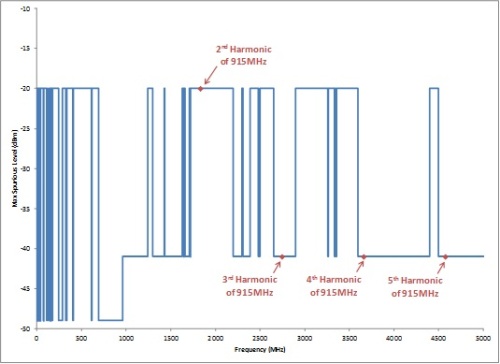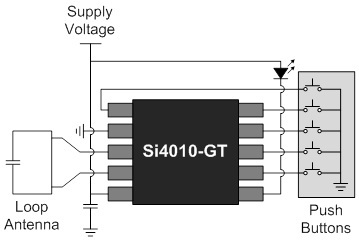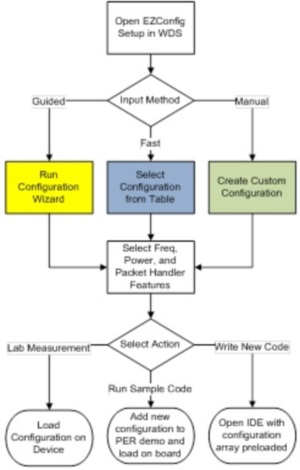Implementing wireless connectivity in consumer electronics products is seldom easy. RF considerations such as antenna design and modulation settings can be very different from the requirements of traditional on-board controls. Regulatory standards and consumer expectations make good wireless performance a necessity. Many inexpensive wireless solutions use basic components with poor performance and are difficult to implement. Solutions that are simple to implement often don't have the flexibility needed for good performance, and these seemingly simple solutions can be costly. If you know what to look for, it's possible to find wireless solutions that offer high performance, ease of use, and low cost.
Regulatory compliance
Frequency usage : Regulatory bodies in each country or region set the most basic performance requirements for wireless systems. These agencies regulate the frequencies on which a given application may operate, the magnitude of radiated emissions and, in many cases, the timing of the transmissions. The specific standards vary widely since each region has allocated the available radio spectrum differently.
Transmit power limitations : The main requirements of these wireless system standards are radiated power versus frequency and the limitation of transmitted power of intended signals and out-of-band spurs and harmonics. (The requirement for the main signal is often specified as both a maximum average power level and a maximum peak power level. For example, FCC Part 15.240 specifies a maximum average field strength of 11 mV/m at 3 m, but allows up to 55 mV/m at 3-m peak field strength. This field strength permits the device to transmit at higher peak power levels if it is duty cycled. Some standards take this requirement even further and set specific guidelines for the periodicity of the transmission or for frequency hopping schemes.
Out-of-band restrictions : Standards bodies provide a limit for any transmitted power outside of the designated band. These restrictions can vary by frequency depending on the importance of the potentially blocked application. The FCC provides a list of restricted bands and allows a maximum of 500-μV/m field strength at 3 m above 960 MHz and 200 μV/m at 3 m below 960 MHz inside these bands. All other frequencies must maintain at least 20-dBc suppression unless using Part 15.249, in which case the –41- and –49-dBm limit applies to all spurs and harmonics. For applications operating in the 902 to 928-MHz band, any near-band spurs and the third harmonic can be particular areas of concern (see Fig. 1 ).

Fig 1. FCC spurious level restrictions by frequency.
Customer expectations
The demands placed on wireless systems by consumers can be even more stringent than the regulatory requirements. The result is an increasing demand for selectivity, range and efficiency.
ReceiversSelectivity : The selectivity of the receiver determines how well it can distinguish the desired transmission from other signals and noise in the area. Achieving good performance generally requires either the addition of filtering or the use of a device with high selectivity and blocking specs. Additional filtering is the least desirable of these two options since it adds both cost and loss to the system, reducing the sensitivity of the receiver.
Range : Having sufficient range to effectively pass through walls and other barriers is usually very important, even when having a long line-of-site range is not critical. Achieving good range depends on the antenna gain, receiver sensitivity and transmitter power. The antenna gain is usually limited by cost and device form factor. Most consumer wireless applications use a PCB trace antenna for cost, but these have poor gain (often less than -20 dB) compared to other antenna options. Receiver sensitivity is another parameter affecting range and is the best variable to optimize if possible. This sets the lower limit on power that can still be received and understood. Finding a receiver with both good sensitivity and selectivity makes it easier to achieve the desired range requirements. This approach also provides more flexibility and design margin for the antenna design and transmitter settings. In addition, range is determined on the transmitter side by the output power level. However, there may be restrictions on how high this can be set. Increasing the transmitter power also increases the current consumption, which can negatively impact on battery life.
Power : Finally, consumers care a great deal about battery life, so the device's power efficiency is critical. To maximize power efficiency, both active and shutdown current are important considerations since most applications employ some form of duty cycling. In applications that spend the majority of the time off, shutdown current can be even more important than active current.
Hardware design considerations
How easily all of these requirements are realized in the wireless application depends on the solution's topology. In general, the higher the integration, the easier the implementation will be. The level of integration ranges from a fully discrete solution requiring transistor biasing and matching up to a fully self-contained integrated solution. Many applications opt for a partially discrete solution, which has the advantage of providing a known transmitter but still requires a number of external components. A fully integrated solution, as shown in Fig. 2 , requires few external components; much of the filtering and tuning is performed internal to the part or by the inherent filtering of the antenna.

Fig 2. Fully integrated transmit solution (Silicon Labs Si4010 Transmitter)
Antenna selection : The most common antenna used in wireless systems is a small PCB trace antenna, but higher gain monopole and wire helical antennas are sometimes used in high-performance applications. The PCB antenna will ideally be one-quarter wavelength on the center frequency used, but product form factor constraints normally restrict the available size and put a greater burden on the matching elements, further reducing antenna gain. Antenna matching and additional filtering depend on the antenna used and wireless IC performance. Little additional filtering may be required if a transmitter with good harmonic performance or a receiver with good selectivity and blocking is used. However, if the wireless device has poor out-of-band performance, special care must be taken to filter out any offending frequencies. The quality of the match will affect the loss of the system. Selecting a receiver with good sensitivity can reduce the margin of error for the match, simplifying the design.
Device configuration considerations
Wireless devices must be configured to correctly send and receive information. Modulation type, data rate, frequency deviation, and receiver bandwidth are some of the basic parameters that determine how device configuration is achieved. The choice of data rate is a balance between a low data rate to optimize range or a high data rate to optimize battery life. Data rate is also affected by the amount of data, with large data applications such as audio or video transmissions requiring higher rates.
The performance of the wireless IC and the accuracy of the frequency source (crystal) affect the frequency deviation and receiver bandwidth. The receiver bandwidth determines how much total noise is allowed in the system and has a major influence on system sensitivity and overall range. However, it must be large enough to account for the transmitter and receiver oscillator tolerance errors and for the frequency deviation distance if frequency shift keying (FSK) modulation is used. Features such as automatic frequency calibration can help keep the receiver bandwidth narrow even if a cheaper, less accurate crystal is selected. Optimizing all of these parameters is critical for good performance.
For some wireless devices, the configuration is performed by setting registers within the part. However, register settings can be difficult since a single configuration parameter may affect multiple register settings. Some devices include application programming interface (API) code that translates the individual register settings into more manageable and more easily understood commands. These commands are then sent to the device through an interface (usually an SPI or I2C interface) between the wireless IC and the microcontroller (MCU).
Easy-to-use configuration tools simplify the development process (as shown in Fig. 3 ), helping the developer determine the optimal settings for each application. A configuration wizard helps ensure that a design stays within the regulatory standards and provides a list of optimized and tested configurations. There is also the option to provide a desired frequency and oscillator tolerance, letting the software determine the receiver bandwidth that will give the best performance. Once this is done,
configuration software can provide all of the code needed to configure the device and can even provide demo code that can be used a starting point for the application program.

Fig.3 Example of wireless device configuration process
Implementing a wireless design can be challenging given the requirements of consumers and various regulatory bodies and the complex decisions that must be made regarding hardware design and system configuration. Fortunately, highly-integrated wireless IC products, such as Silicon Labs' EZRadio devices, can provide inexpensive, easy-to-implement solutions that offer the high performance needed to satisfy regulatory standards and consumer needs while providing on-chip features and development tools that make it easier to add wireless connectivity to virtually any embedded application.
Advertisement
Learn more about Silicon Labs





